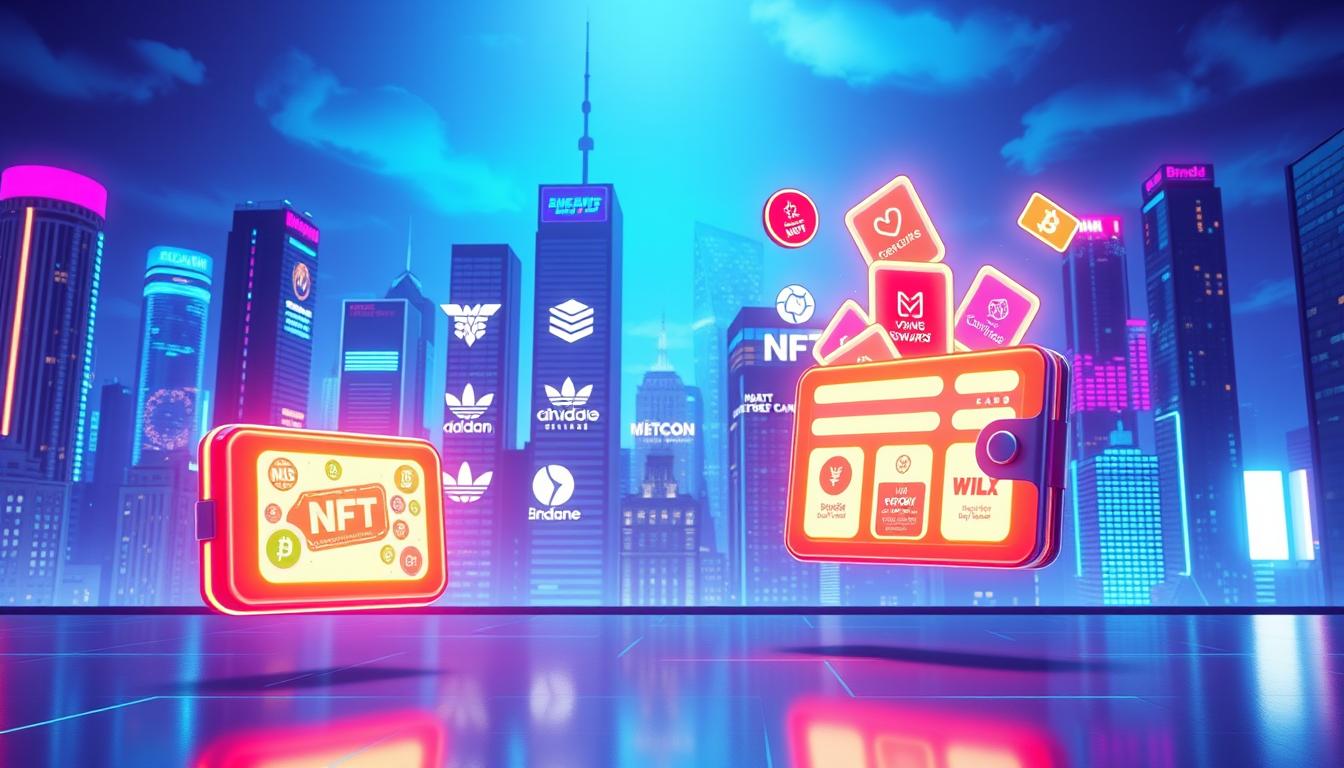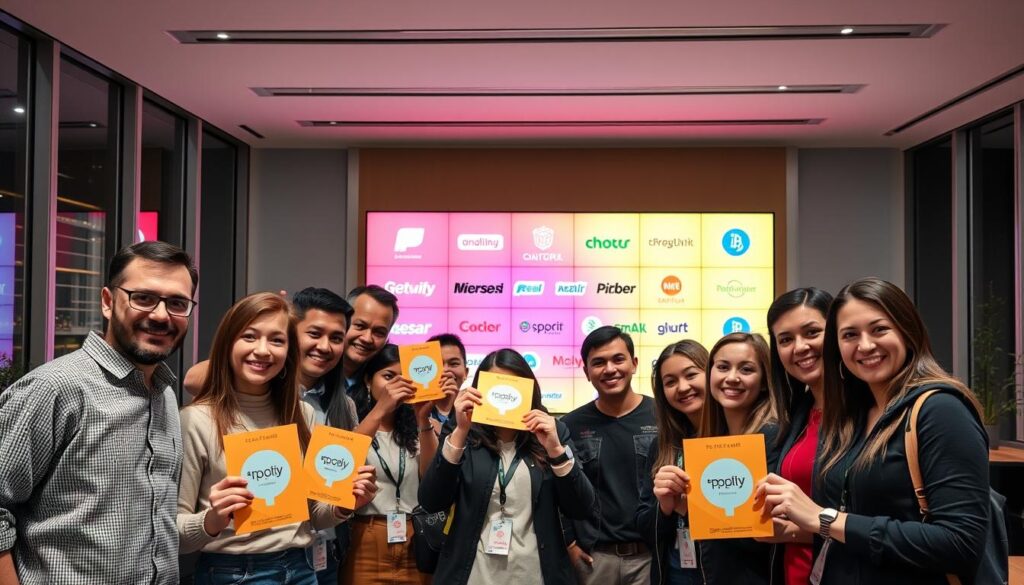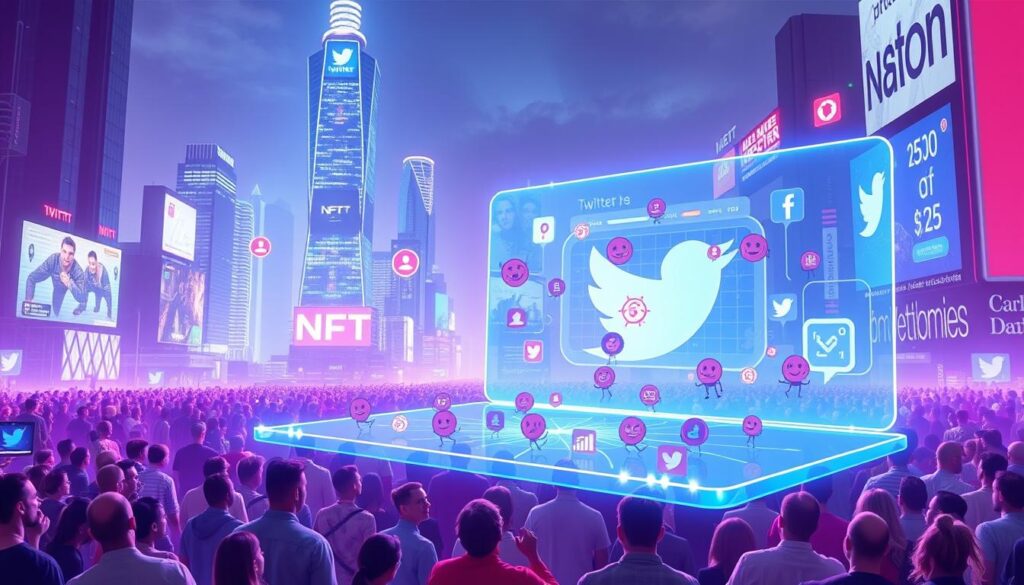Now Reading: How Brands Use NFTs for Loyalty Rewards
- 01
How Brands Use NFTs for Loyalty Rewards
How Brands Use NFTs for Loyalty Rewards

NFT loyalty programs are changing how brands connect with their customers. They offer a fresh way to reward loyalty. By using NFTs, companies can make experiences that feel more personal and build stronger bonds with their audience. This can help keep customers coming back and grow the business.
Studies show that good loyalty programs really boost customer involvement. NFT rewards are a big part of this success. As brands move online, trying new loyalty ideas like NFTs is key.
Introduction to NFT Loyalty
NFT loyalty programs bring many benefits for both brands and customers. They help keep customers engaged and make programs clearer. By using NFTs, companies can offer a more engaging and rewarding experience. This can lead to success for the business.
Key Takeaways
- NFT loyalty programs offer a unique approach to customer engagement
- NFTs in brand loyalty can increase customer retention and drive business growth
- Successful loyalty programs can significantly impact customer engagement
- NFT loyalty rewards can provide a more immersive experience for customers
- NFT loyalty programs can improve program transparency and security
Understanding NFT-Based Loyalty Programs
NFT-based loyalty programs are changing how brands connect with their customers. They use digital loyalty strategies to offer unique experiences. This builds loyalty and keeps customers coming back.
These programs give exclusive rewards and experiences. This makes customers feel special and valued.
Some benefits of NFT-based loyalty programs include:
- Increased customer engagement through loyalty program strategies
- Improved program transparency and security
- Enhanced customer experiences through exclusive rewards and events
Traditional loyalty programs can’t match the personal touch of NFT-based ones. NFT-based loyalty lets brands offer a deeper, more interactive experience.
As NFTs become more common in loyalty programs, it’s key for brands to grasp their unique benefits. This helps drive customer engagement and loyalty.
The Evolution of Brand Loyalty in the Digital Age
Brands need to understand how customer loyalty has changed. The brand loyalty evolution is huge, thanks to digital tech. Now, customers want personalized experiences, ease, and rewards that fit their lives.
Loyalty programs have grown from simple rewards to complex systems. Brands must use new customer loyalty strategies to keep up. This means focusing on engaging with customers, being open, and being flexible. This way, they can build strong relationships and grow over time.
Important parts of brand loyalty evolution in the digital age include:
- Personalization: offering tailored experiences and rewards to individual customers
- Omnichannel engagement: interacting with customers across multiple channels and touchpoints
- Transparency: providing clear information about loyalty programs and rewards
By adopting these digital age loyalty aspects, brands can make effective customer loyalty strategies. These strategies meet customer needs and help businesses succeed.
Core Benefits of NFT Loyalty Rewards for Brands
NFT loyalty rewards bring many benefits to brands. They help in boosting customer engagement and making programs more transparent. Brands can make their loyalty programs more engaging and cost-effective by using NFTs. Customer engagement strategies work well with NFT loyalty rewards, offering a fresh way to reward customer loyalty.
Some key benefits of NFT loyalty rewards are:
- Enhanced customer engagement through unique and exclusive rewards
- Increased program transparency through blockchain technology
- Reduced administrative costs through automated loyalty program management
- Secondary market opportunities for customers to buy, sell, and trade NFT rewards
Understanding the benefits of NFT loyalty helps brands create more effective loyalty programs. With the right customer engagement strategies and program transparency, brands can fully benefit from NFT loyalty rewards. This can take their loyalty programs to the next level.
How Brands Use NFTs for Loyalty Rewards: Strategic Implementation
Effective NFT loyalty implementation needs careful planning. Brands must think about their brand loyalty strategies. They should see how NFTs can keep customers coming back.
Brands can make NFTs part of their loyalty programs. This way, they offer special experiences to their customers.
Understanding how NFTs reward customers is key. Brands can give out special NFTs for exclusive access. This builds a community feeling among customers, which is great for loyalty.
Some brands have already made NFT loyalty programs work. They show how it can help. By using NFT loyalty implementation in their brand loyalty strategies, brands can stay ahead. For more on loyalty programs, check out loyalty program resources.
Here are some benefits of NFT loyalty programs:
- Increased customer engagement
- Improved program transparency
- Enhanced customer retention

Technical Requirements for NFT Loyalty Programs
When setting up NFT loyalty programs, it’s key to think about the NFT technical requirements. This ensures a smooth and safe experience for customers. Choosing the right blockchain platform for loyalty is crucial. It needs to be scalable and secure.
Smart contract development is also vital. It allows for unique and personalized rewards for customers. Using blockchain for loyalty makes programs transparent and unchangeable.
Key Considerations for Blockchain Platform Selection
- Scalability and performance
- Security and immutability
- Smart contract functionality
Smart Contract Development Best Practices
Brands should aim to create secure and efficient smart contracts for NFT loyalty programs. This ensures they meet their specific needs.
Creating Value Through NFT Reward Tiers
Creating NFT reward tiers is key to a loyalty program’s success. Understanding how rewards work can help brands make NFT reward tiers that customers love. Studies show that people enjoy programs that offer loyalty program value and special rewards.
A good NFT loyalty program helps keep customers coming back. Brands can do this by giving rewards that match what customers like. For instance, offering early access to new items or sales can keep customers excited. Using NFT reward tiers makes customers feel like they’re getting better with each step.
When making NFT reward tiers, consider these points:
- Make the rewards clear and easy to understand
- Give special rewards and benefits
- Build a community where people can share and connect
With these ideas, brands can make an NFT loyalty program that really adds value. It will keep customers engaged for a long time.
Designing Engaging NFT Loyalty Experiences
Creating fun experiences for NFT loyalty program members is key to keeping them involved. By adding gamification in loyalty programs, brands can make things exciting and competitive. This can happen through rewards, challenges, and leaderboards that push members to interact and share their experiences.
Great NFT loyalty experiences also offer exclusive access programs. These give members special perks like early product access, discounts, or VIP events. Such programs help build a community feeling, leading to more loyalty and support.
When making engaging NFT loyalty experiences, consider these important points:
- Clear goals and rewards structures
- Interactive and immersive experiences
- Personalization and tailored offers
- Community building features, such as forums or social media groups
By using these elements and gamification in loyalty and exclusive access programs, brands can make NFT loyalty experiences that boost engagement, retention, and loyalty.
Success Stories: Brands Leading in NFT Loyalty
Many brands have started using NFTs for loyalty rewards. They’ve created innovative loyalty programs that have seen great success. These NFT loyalty success stories can teach other brands a lot.
Nike and Adidas are great examples. They’ve used NFTs to thank customers for their loyalty. These efforts have not only made customers more engaged but also brought in new money for the brands.
What makes these NFT loyalty programs stand out? Here are some key points:
- Unique digital rewards that can be stored and traded
- Exclusive access to limited-edition products or experiences
- Community-building features that foster engagement and loyalty

By looking at these NFT loyalty success stories and brand loyalty examples, other brands can learn. They can see how to make innovative loyalty programs that keep customers coming back.
Overcoming Common NFT Loyalty Program Challenges
Starting NFT loyalty programs can be tough. Brands often hit roadblocks. One big NFT loyalty challenge is making sure users get the program. This is where user education is key. Clear info helps users use the program to its fullest.
Brands face several hurdles when they start NFT loyalty programs. These include:
- Technical issues like scalability and security
- Regulatory compliance needs constant updates
- High costs can stop smaller brands from joining
To beat these challenges, brands should focus on user education and onboarding. They need to make sure users know the program’s perks. Investing in solid tech and keeping up with regulatory compliance also helps. By tackling these NFT loyalty challenges, brands can make engaging programs that boost customer loyalty.
Measuring NFT Loyalty Program Success
To see if an NFT loyalty program works, it’s key to watch certain numbers. Measuring loyalty success means looking at customer engagement metrics. This includes how many people join, how often they use rewards, and how happy they are.
Tracking these numbers helps brands see what’s working and what’s not. They can then make changes to improve their programs. This way, they can better meet what customers want.
Important NFT program metrics include how many join, how often they use rewards, and what rewards they like best. By studying these, brands can make their programs more engaging. This boosts customer engagement and builds lasting loyalty.
By checking these numbers often and making smart choices based on the data, brands can make their NFT loyalty programs a hit. This helps them build strong, lasting bonds with their customers.
Integration Strategies with Existing Loyalty Systems
When adding NFT loyalty programs to current systems, think about how to move data. This means moving customer info from old systems to new NFT ones smoothly. This way, businesses can make customer experiences better and get more people involved.
To do it right, the new NFT program should work well with the old one. This means focusing on making the transition easy for customers. Some good ways to do this include:
- Using APIs to link the old system with the new NFT platform
- Looking at data to see how to make both systems better
- Making the new NFT program easy for customers to use
By combining NFT loyalty with old systems, companies can make a better rewards program.
As businesses grow and change, adding NFT loyalty to old systems helps them stay ahead. By focusing on moving data well and making things easy for customers, companies can make a loyalty program that works well. This helps them grow and succeed over time.
Best Practices for NFT Reward Distribution
Effective NFT reward distribution is key to keeping customers engaged and loyal. Studies show that personalized and timely rewards boost retention and satisfaction. Brands should aim for best practices like clear reward tiers, exclusive experiences, and smooth loyalty program management.
A good NFT reward distribution system should have a few key parts:
- Clear communication of reward rules and tiers
- Regular updates on reward availability and expiration dates
- Personalized reward offers based on customer preferences and behavior
By sticking to these best practices and using data on effective strategies, brands can run successful 
Cost Considerations and ROI Analysis
When starting NFT loyalty programs, it’s key to think about costs and do a detailed ROI analysis. NFT loyalty costs change based on the program’s size and complexity. Brands need to balance the upfront costs with the potential gains and expected outcomes.
Success in NFT loyalty programs depends a lot on the investment requirements. This includes the cost of setting up the program, making the NFTs, and linking it with current systems. Doing a deep ROI analysis helps brands see if their investment is paying off and guides their choices.
Initial Investment Requirements
The first costs for an NFT loyalty program cover developing it, making the NFTs, and linking it with current systems.
Ongoing Operational Costs
Costs keep going for keeping the program running, updating NFTs, and helping customers.
Expected Returns and Timeframes
The returns on investment can change based on how well the program does and when those returns come. Brands should check their ROI analysis often to see if the program is hitting its targets and tweak it if needed.
Security Measures for NFT Loyalty Programs
Keeping NFT loyalty programs safe is key to protecting customer data. It’s important to prevent unauthorized access and data breaches. This means using strong security measures to keep data safe.
Brands can take several steps to secure their NFT loyalty programs. These steps include:
- Using secure blockchain platforms and smart contracts to prevent tampering and unauthorized access
- Implementing robust access controls and authentication mechanisms to prevent unauthorized access
- Regularly updating and patching software and systems to prevent vulnerabilities
- Conducting regular security audits and penetration testing to identify and address potential vulnerabilities
By focusing on NFT loyalty security, brands can protect their customers’ data. This builds trust and loyalty, leading to long-term success.
Customer Data Privacy and NFT Rewards
Brands are looking into NFT loyalty programs more and more. But, they must focus on customer data privacy first. With digital tech growing, keeping personal info safe is key. NFT rewards need strong data protection to follow rules like GDPR.
Keeping customer data safe is very important. Brands should tell customers how they use their info. They also need to make sure data is not stolen or lost.
To follow GDPR compliance, brands must follow strict rules. They need to get clear consent from customers. They also have to tell customers how their data is used and keep it safe.
Here are some ways to protect customer data in NFT programs:
- Use strong encryption to keep data safe during and after it’s sent or stored.
- Do regular security checks to find and fix any weak spots.
- Give customers clear info on how their data is collected and used.
By focusing on customer data privacy and using good data protection methods, brands can gain trust. This is crucial for the success of their NFT loyalty programs.
Embracing the Future of Digital Loyalty with NFTs
The use of NFTs in loyalty programs is changing the game. These digital assets open up new ways for brands to connect with their customers. They make experiences more immersive and engaging.
By using NFTs, brands can build stronger bonds with their customers. They can encourage more participation and create a sense of uniqueness. This is something traditional loyalty programs can’t match.
The future of digital loyalty looks bright with NFTs leading the way. As people get more tech-savvy, they want experiences that are personal and interactive. Brands that use NFT-based loyalty programs will stand out.
They can tap into the excitement around digital collectibles. This creates a world where customers are eager to engage and support the brand.
The growth of innovative loyalty programs with NFTs marks a new chapter in customer interaction. It’s a time when the physical and digital worlds come together seamlessly. Brands that master NFTs will build lasting relationships and stay ahead in the digital engagement game.
FAQ
What are NFT-based loyalty programs?
NFT-based loyalty programs use special tokens called non-fungible tokens (NFTs) to reward customers. These programs let brands give out unique digital items or special experiences. Customers can earn or buy these rewards.
How do NFT loyalty programs differ from traditional loyalty programs?
NFT programs are different because they are more open and engaging. They also let customers trade rewards and save money on administration. Plus, the rewards are more personal and valuable.
What are the benefits of using NFTs for brand loyalty?
Using NFTs for loyalty boosts customer interaction and makes programs clearer. It also cuts down on costs and opens up new market chances. NFT rewards are unique and valuable, helping keep customers loyal.
What are the core components of an NFT loyalty system?
An NFT loyalty system needs a blockchain, smart contracts, and a user-friendly interface. Brands must pick the right blockchain, create secure smart contracts, and design an easy-to-use interface for success.
How can brands create value through NFT reward tiers?
Brands can make value by creating a tiered system of rewards. This includes rare collectibles, special passes, and unique experiences. Each tier should appeal to different customers, making it engaging and loyal-building.
What are some common challenges in implementing NFT loyalty programs?
Challenges include teaching customers, dealing with tech issues, and following laws. Brands need to educate customers well, have strong tech, and follow laws to succeed.
How can brands measure the success of their NFT loyalty programs?
Success can be measured by looking at customer interaction, program use, and market activity. It’s also important to see how it affects keeping customers and their lifetime value. Setting clear goals and metrics is key.
What are the cost considerations and ROI analysis for NFT loyalty programs?
Starting NFT programs costs money for tech, design, and support. Ongoing costs include upkeep and fees. Brands must look at expected returns and time to ensure a good ROI.
How can brands ensure the security of their NFT loyalty programs?
Security is vital. Brands should use strong protection, like secure keys, audits, and threat monitoring. They also need to follow data privacy laws to keep customer info safe.
What is the future of digital loyalty with NFTs?
The future looks bright for NFT loyalty. These tokens will change how brands keep and engage customers. As tech grows, we’ll see more creative and immersive programs that offer real value.














